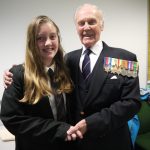The D ay Sussex Died
ay Sussex Died
Sound Architect Creative Media is working with Eastbourne PALS on this Heritage Lottery funded WW1 project where a class of Year 8 students from St Catherine’s College, Eastbourne, formerly the Bishop Bell School, are honouring and respecting the memory and the sacrifice of these brave Sussex men.
Chris Richards from PALS said: “It’s very important to keep this history alive, even though no doubt 100 years seems like a long time ago to the students. The Battle of Boars Head was hugely significant to Sussex, especially the Eastbourne area.” The battle, in Richebourg, France, took place on 30 June 1916 and over 1000 Sussex men were killed or wounded. The attack was a crucial strategic manoeuvre to deflect attention from the attack at the Somme further to the North which was due to start the next day: both battles of course resulted in a tragic loss of life.
The project researches the local contribution to raising a citizens’ army during the First World War and its impact on Eastbourne and other Sussex towns and villages. It also promotes and encourages community participation in the 100th anniversary commemoration of the Royal Sussex Regiment’s 11th 12th & 13th Southdown’s Battalions (Lowther’s Lambs) Boar’s Head action in France, particularly amongst the descendants of those involved. The project provides an information booklet and DVD record about Boar’s Head which was exhibited at the Eastbourne Redoubt Military Museum.
Students from St Catherine’s College interviewed a local Second World War Veteran as part of the project. Harry Waddingham, step great grandfather to Robyn Foster in the class of year 8 from the school in Langney, Eastbourne, came in to talk about some of his experiences, giving the class a unique insight into what it was like to live in those times.
Said teacher, Mrs Jenny Clifton, “It is a fascinating insight into a time these students have never known and by listening to real life stories it helps them to understand. Through researching this project, the students are discovering all sorts of local connections. This makes it real for them, not just history.”
Click here to read the booklet
